lock MAZDA MODEL 5 2012 User Guide
[x] Cancel search | Manufacturer: MAZDA, Model Year: 2012, Model line: MODEL 5, Model: MAZDA MODEL 5 2012Pages: 440, PDF Size: 5.51 MB
Page 24 of 440

Black plate (24,1)
Seat Arrangements
Illustrations are of representative seat arrangements.
WARNING
Do not arrange the seats while driving:Arranging the seats while driving is dangerous because you do not get the full
protection from seat belts and you cannot keep your balance. During sudden
braking or a collision, it could cause serious injuries.
Do not ride on seatbacks that are folded flat: Sitting or lying on seats that are folded flat is a dangerous way to ride. During
sudden braking or a collision you could be thrown around inside the vehicle and
seriously injured.
Make sure the adjustable components of a seat are locked in place: Adjustable seats that are not securely locked are dangerous. In a sudden stop or
collision, the seat or seatback could move, causing injury.
2-12
Essential Safety Equipment
Seats
Mazda5_8BR9-EA-10J_Edition3 Page24
Monday, February 21 2011 1:44 PM
Form No.8BR9-EA-10J
Page 27 of 440
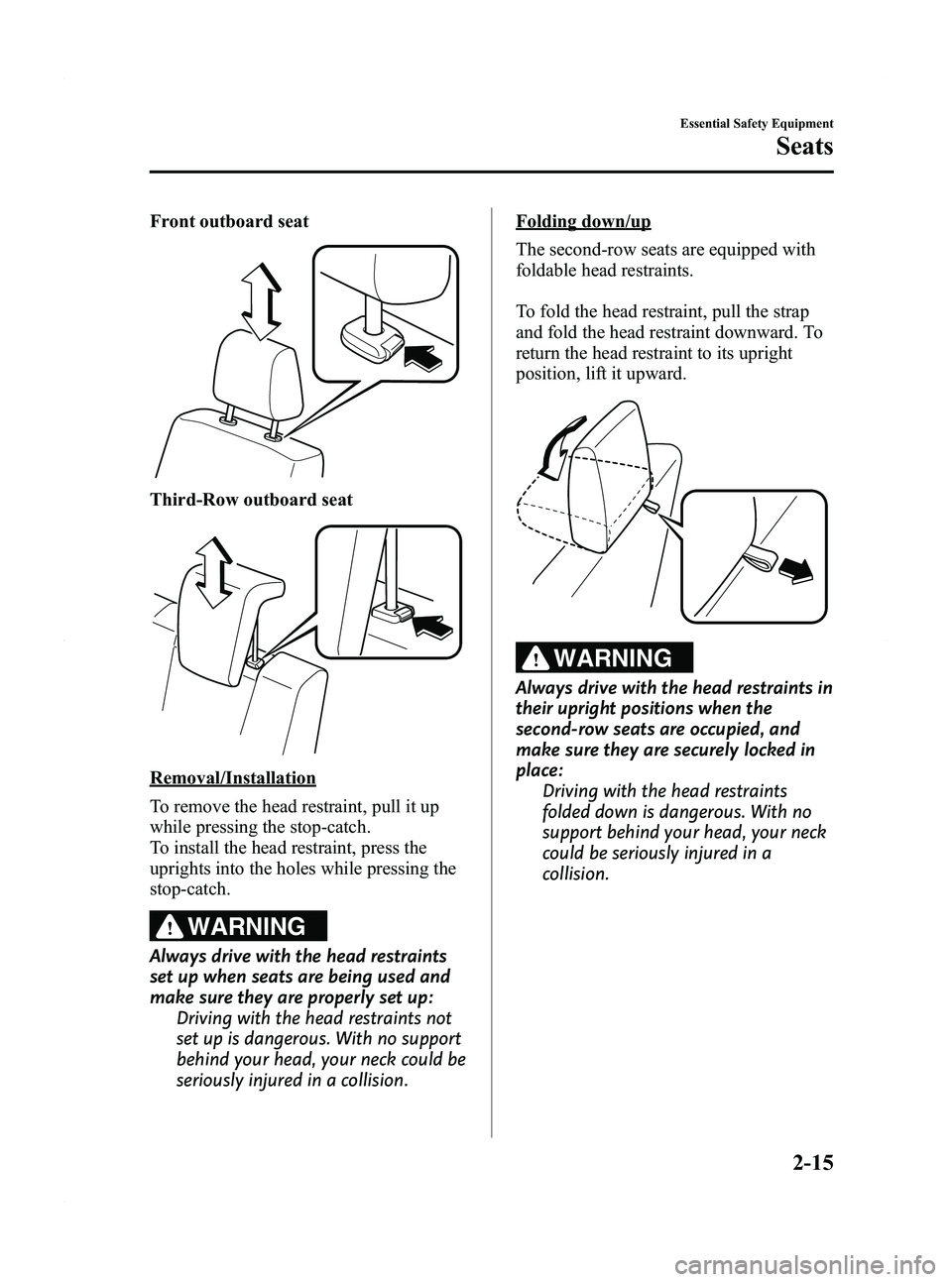
Black plate (27,1)
Front outboard seat
Third-Row outboard seat
Removal/Installation
To remove the head restraint, pull it up
while pressing the stop-catch.
To install the head restraint, press the
uprights into the holes while pressing the
stop-catch.
WARNING
Always drive with the head restraints
set up when seats are being used and
make sure they are properly set up:Driving with the head restraints not
set up is dangerous. With no support
behind your head, your neck could be
seriously injured in a collision.
Folding down/up
The second-row seats are equipped with
foldable head restraints.
To fold the head restraint, pull the strap
and fold the head restraint downward. To
return the head restraint to its upright
position, lift it upward.
WARNING
Always drive with the head restraints in
their upright positions when the
second-row seats are occupied, and
make sure they are securely locked in
place:
Driving with the head restraints
folded down is dangerous. With no
support behind your head, your neck
could be seriously injured in a
collision.
Essential Safety Equipment
Seats
2-15
Mazda5_8BR9-EA-10J_Edition3 Page27
Monday, February 21 2011 1:44 PM
Form No.8BR9-EA-10J
Page 30 of 440
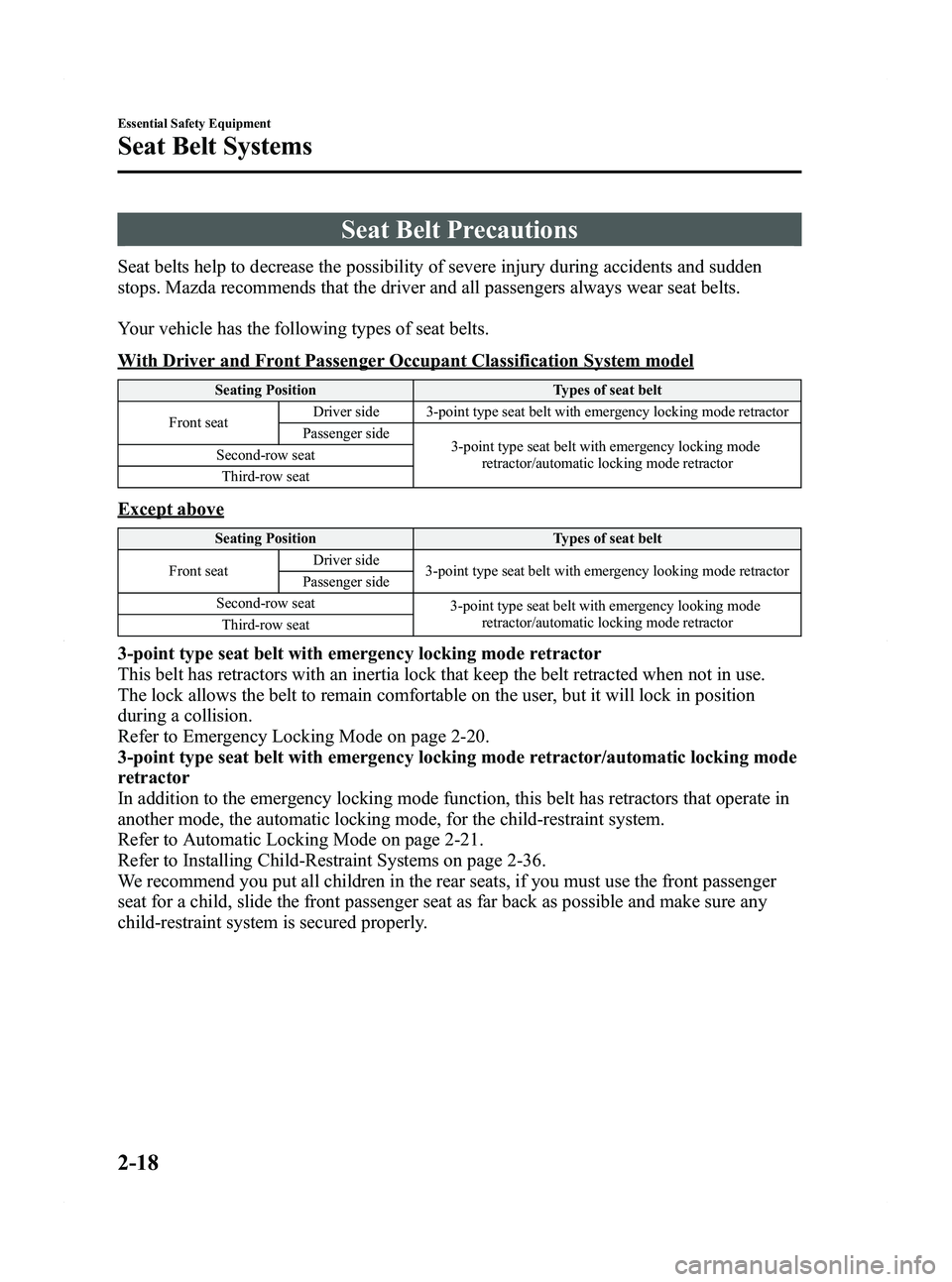
Black plate (30,1)
Seat Belt Precautions
Seat belts help to decrease the possibility of severe injury during accidents and sudden
stops. Mazda recommends that the driver and all passengers always wear seat belts.
Your vehicle has the following types of seat belts.
With Driver and Front Passenger Occupant Classification System model
Seating PositionTypes of seat belt
Front seat Driver side 3-point type seat belt with emergency locking mode retractor
Passenger side 3-point type seat belt with emergency locking mode
retractor/automatic locking mode retractor
Second-row seat
Third-row seat
Except above
Seating Position Types of seat belt
Front seat Driver side
3-point type seat belt with emergency looking mode retractor
Passenger side
Second-row seat 3-point type seat belt with emergency looking mode
retractor/automatic locking mode retractor
Third-row seat
3-point type seat belt with emergency locking mode retractor
This belt has retractors with an inertia lock that keep the belt retracted when not in use.
The lock allows the belt to remain comfortable on the user, but it will lock in position
during a collision.
Refer to Emergency Locking Mode on page 2-20.
3-point type seat belt with emergency locking mode retractor/automatic locking mode
retractor
In addition to the emergency locking mode function, this belt has retractors that operate in
another mode, the automatic locking mode, for the child-restraint system.
Refer to Automatic Locking Mode on page 2-21.
Refer to Installing Child-Restraint Systems on page 2-36.
We recommend you put all children in the rear seats, if you must use the front passenger
seat for a child, slide the front passenger seat as far back as possible and make sure any
child-restraint system is secured properly.
2-18
Essential Safety Equipment
Seat Belt Systems
Mazda5_8BR9-EA-10J_Edition3 Page30
Monday, February 21 2011 1:44 PM
Form No.8BR9-EA-10J
Page 32 of 440
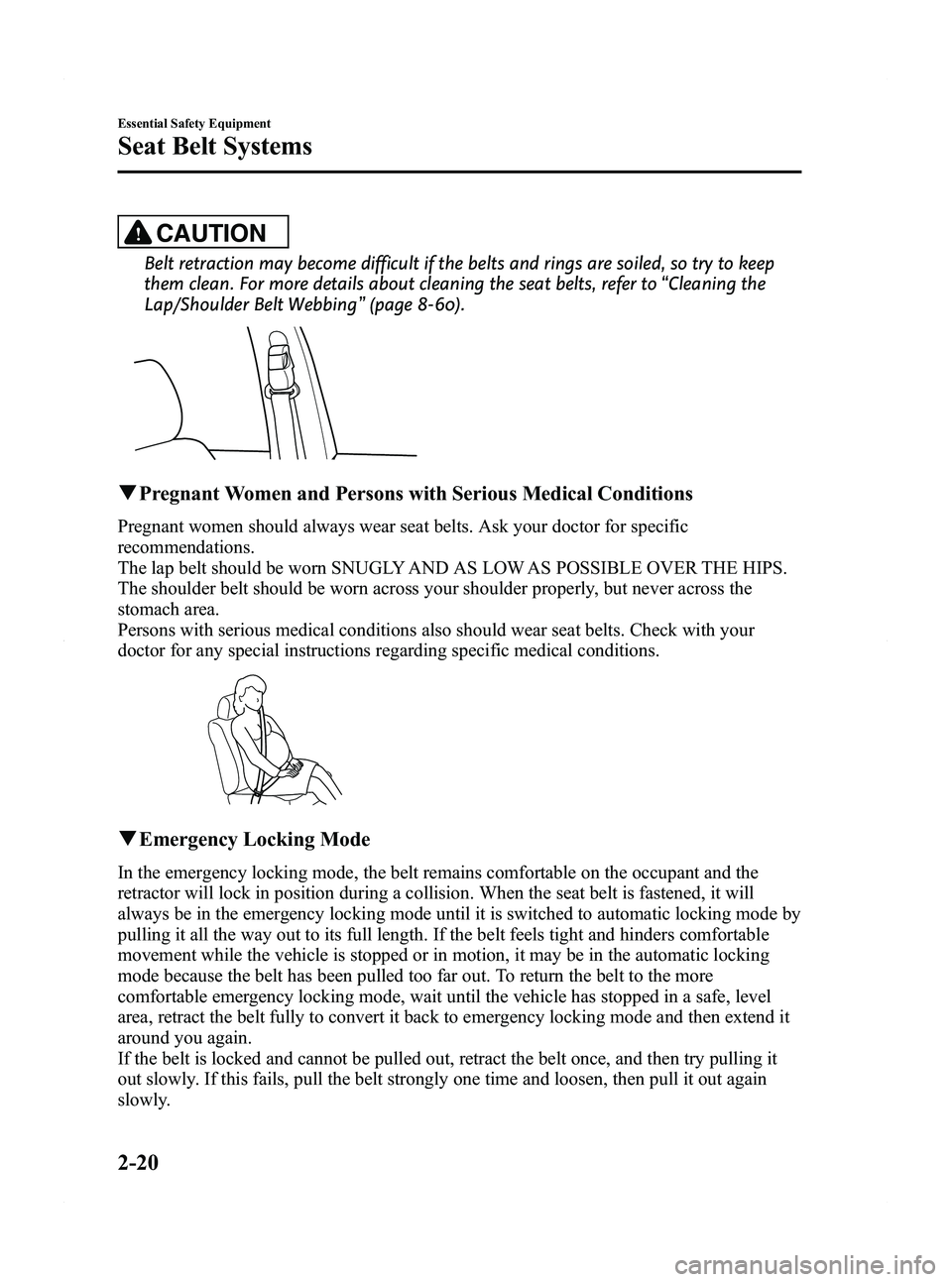
Black plate (32,1)
CAUTION
Belt retraction may become difficult if the belts and rings are soiled, so try to keep
them clean. For more details about cleaning the seat belts, refer to“Cleaning the
Lap/Shoulder Belt Webbing ”(page 8-60).
q Pregnant Women and Persons with Serious Medical Conditions
Pregnant women should always wear seat belts. Ask your doctor for specific
recommendations.
The lap belt should be worn SNUGLY AND AS LOW AS POSSIBLE OVER THE HIPS.
The shoulder belt should be worn across your shoulder properly, but never across the
stomach area.
Persons with serious medical conditions also should wear seat belts. Check with your
doctor for any special instructions regarding specific medical conditions.
qEmergency Locking Mode
In the emergency locking mode, the belt remains comfortable on the occupant and the
retractor will lock in position during a collision. When the seat belt is fastened, it will
always be in the emergency locking mode until it is switched to automatic locking mode by
pulling it all the way out to its full length. If the belt feels tight and hinders comfortable
movement while the vehicle is stopped or in motion, it may be in the automatic locking
mode because the belt has been pulled too far out. To return the belt to the more
comfortable emergency locking mode, wait until the vehicle has stopped in a safe, level
area, retract the belt fully to convert it back to emergency locking mode and then extend it
around you again.
If the belt is locked and cannot be pulled out, retract the belt once, and then try pulling it
out slowly. If this fails, pull the belt strongly one time and loosen, then pull it out again
slowly.
2-20
Essential Safety Equipment
Seat Belt Systems
Mazda5_8BR9-EA-10J_Edition3 Page32
Monday, February 21 2011 1:44 PM
Form No.8BR9-EA-10J
Page 33 of 440
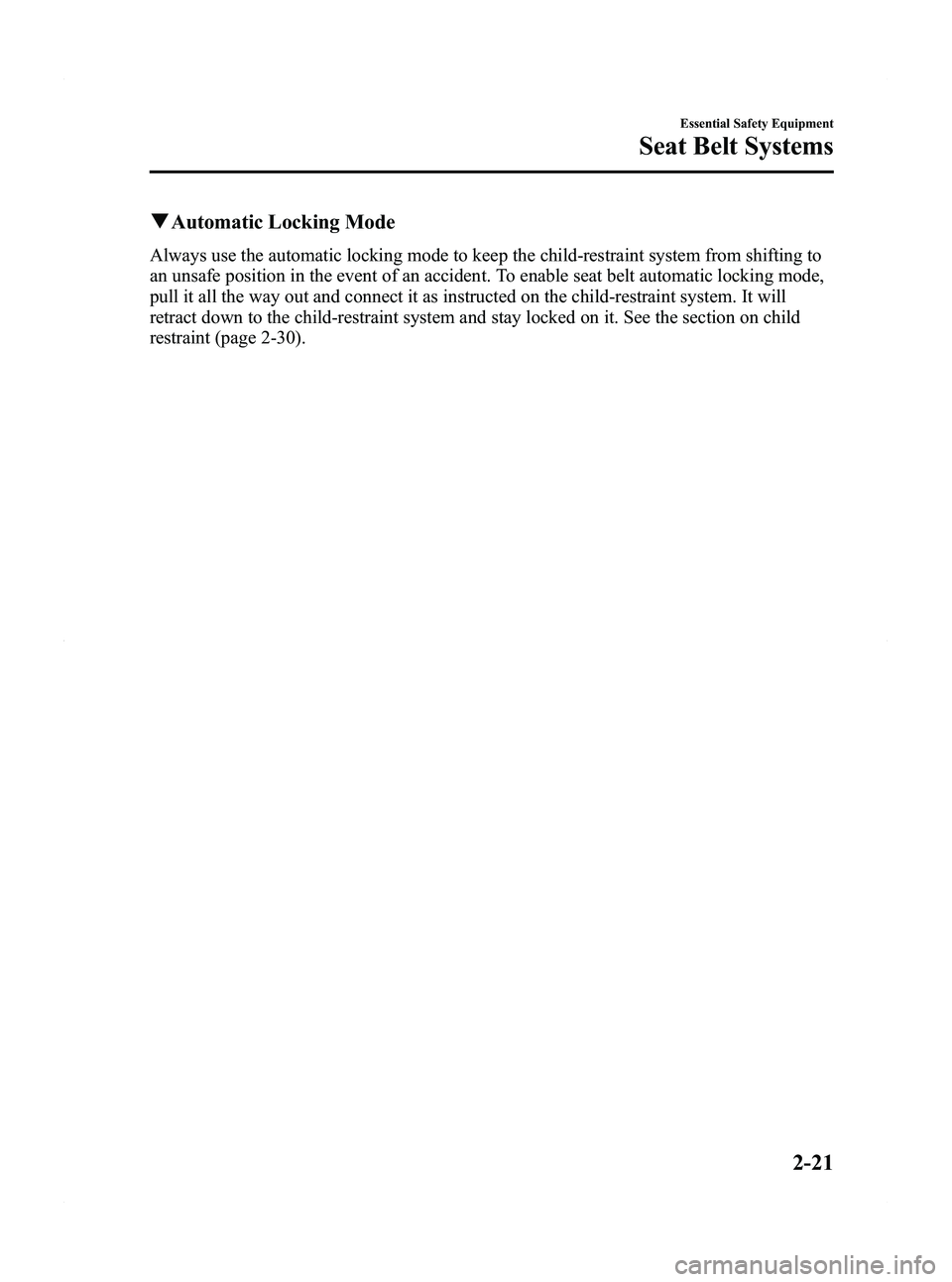
Black plate (33,1)
qAutomatic Locking Mode
Always use the automatic locking mode to keep the child-restraint system from shifting to
an unsafe position in the event of an accident. To enable seat belt automatic locking mode,
pull it all the way out and connect it as instructed on the child-restraint system. It will
retract down to the child-restraint system and stay locked on it. See the section on child
restraint (page 2-30).
Essential Safety Equipment
Seat Belt Systems
2-21
Mazda5_8BR9-EA-10J_Edition3 Page33
Monday, February 21 2011 1:44 PM
Form No.8BR9-EA-10J
Page 35 of 440
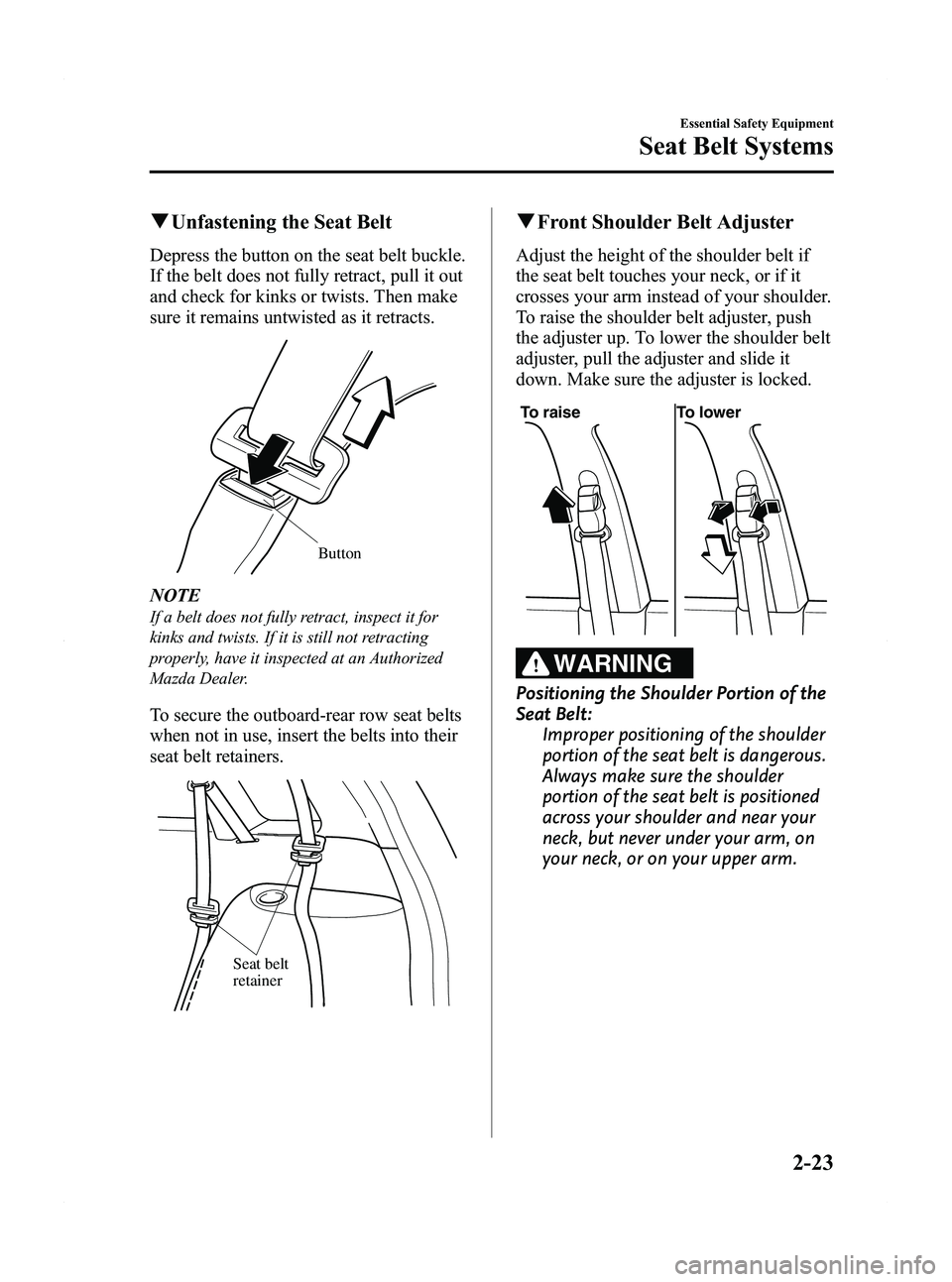
Black plate (35,1)
qUnfastening the Seat Belt
Depress the button on the seat belt buckle.
If the belt does not fully retract, pull it out
and check for kinks or twists. Then make
sure it remains untwisted as it retracts.
Button
NOTE
If a belt does not fully retract, inspect it for
kinks and twists. If it is still not retracting
properly, have it inspected at an Authorized
Mazda Dealer.
To secure the outboard-rear row seat belts
when not in use, insert the belts into their
seat belt retainers.
Seat belt
retainer
qFront Shoulder Belt Adjuster
Adjust the height of the shoulder belt if
the seat belt touches your neck, or if it
crosses your arm instead of your shoulder.
To raise the shoulder belt adjuster, push
the adjuster up. To lower the shoulder belt
adjuster, pull the adjuster and slide it
down. Make sure the adjuster is locked.
To raise To lower
WARNING
Positioning the Shoulder Portion of the
Seat Belt:
Improper positioning of the shoulder
portion of the seat belt is dangerous.
Always make sure the shoulder
portion of the seat belt is positioned
across your shoulder and near your
neck, but never under your arm, on
your neck, or on your upper arm.
Essential Safety Equipment
Seat Belt Systems
2-23
Mazda5_8BR9-EA-10J_Edition3 Page35
Monday, February 21 2011 1:44 PM
Form No.8BR9-EA-10J
Page 45 of 440

Black plate (45,1)
Seating a child in a child-restraint system on the front passenger seat is dangerous
under certain conditions (With Driver and Front Passenger Occupant Classification
System):Your vehicle is equipped with front passenger seat weight sensors. Even with the
front passenger seat weight sensors, if you must use the front passenger seat to seat
a child, using a child-restraint system on the front passenger seat under the
following conditions increases the danger of the front passenger air bag deploying
and could result in serious injury or death to the child.
ØThe front passenger air bag deactivation indicator light does not illuminate when
seating a child in the child-restraint system.
Ø Luggage or other items are placed on the seat with the child in the child-restraint
system.
Ø A rear passenger or luggage pushing or pulling down on the front passenger
seatback.
Ø A rear passenger puts their feet on the front seat rails.
Ø Luggage or other items are placed on the seatback or hung on the head restraint.
Ø Heavy items are placed in the seatback map pocket.
Ø The seat is washed.
Ø Liquids are spilled on the seat.
Ø The front passenger seat is moved backward, pushing into luggage or other items
placed behind it.
Ø The front passenger seatback contacts the second-row seat.
Ø Luggage or other items are placed between the front passenger seat and driver
seat.
Ø Any accessories, which might increase the total seated weight on the front
passenger seat, are attached to the front passenger seat.
The designated positions with seat belts on the rear seats are the safest places for
children. Always use seat belts and child restraints.
Do not allow a child or anyone to lean over or against the side window of a vehicle
with side and curtain air bags: It is dangerous to allow anyone to lean over or against the side window, the area of
the front passenger seat, the front and rear window pillars and the roof edge along
both sides from which the side and curtain air bags deploy, even if a child-restraint
system is used. The impact of inflation from a side or curtain air bag could cause
serious injury or death to an out of position child. Furthermore, leaning over or
against the front door could block the side and curtain air bags and eliminate the
advantages of supplemental protection. With the front air bag and the additional
side air bag that comes out of the front seat, the rear seat is always a better location
for children. Take special care not to allow a child to lean over or against the side
window, even if the child is seated in a child-restraint system.
Essential Safety Equipment
Child Restraint
2-33
Mazda5_8BR9-EA-10J_Edition3 Page45
Monday, February 21 2011 1:44 PM
Form No.8BR9-EA-10J
Page 48 of 440
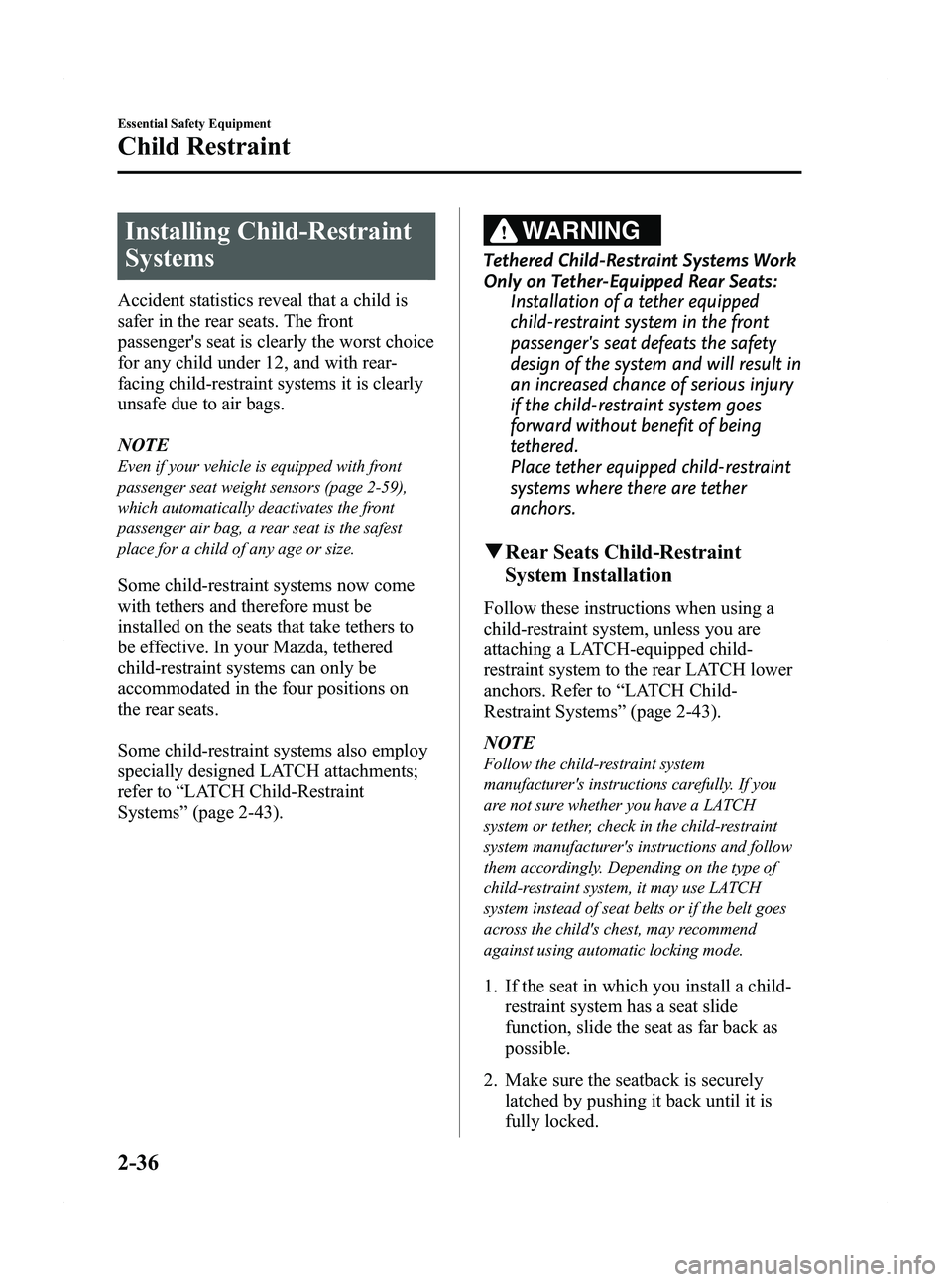
Black plate (48,1)
Installing Child-Restraint
Systems
Accident statistics reveal that a child is
safer in the rear seats. The front
passenger's seat is clearly the worst choice
for any child under 12, and with rear-
facing child-restraint systems it is clearly
unsafe due to air bags.
NOTE
Even if your vehicle is equipped with front
passenger seat weight sensors (page 2-59),
which automatically deactivates the front
passenger air bag, a rear seat is the safest
place for a child of any age or size.
Some child-restraint systems now come
with tethers and therefore must be
installed on the seats that take tethers to
be effective. In your Mazda, tethered
child-restraint systems can only be
accommodated in the four positions on
the rear seats.
Some child-restraint systems also employ
specially designed LATCH attachments;
refer to“LATCH Child-Restraint
Systems ”(page 2-43).
WARNING
Tethered Child-Restraint Systems Work
Only on Tether-Equipped Rear Seats:
Installation of a tether equipped
child-restraint system in the front
passenger's seat defeats the safety
design of the system and will result in
an increased chance of serious injury
if the child-restraint system goes
forward without benefit of being
tethered.
Place tether equipped child-restraint
systems where there are tether
anchors.
qRear Seats Child-Restraint
System Installation
Follow these instructions when using a
child-restraint system, unless you are
attaching a LATCH-equipped child-
restraint system to the rear LATCH lower
anchors. Refer to “LATCH Child-
Restraint Systems ”(page 2-43).
NOTE
Follow the child-restraint system
manufacturer's instructions carefully. If you
are not sure whether you have a LATCH
system or tether, check in the child-restraint
system manufacturer's instructions and follow
them accordingly. Depending on the type of
child-restraint system, it may use LATCH
system instead of seat belts or if the belt goes
across the child's chest, may recommend
against using automatic locking mode.
1. If the seat in which you install a child- restraint system has a seat slide
function, slide the seat as far back as
possible.
2. Make sure the seatback is securely latched by pushing it back until it is
fully locked.
2-36
Essential Safety Equipment
Child Restraint
Mazda5_8BR9-EA-10J_Edition3 Page48
Monday, February 21 2011 1:44 PM
Form No.8BR9-EA-10J
Page 49 of 440
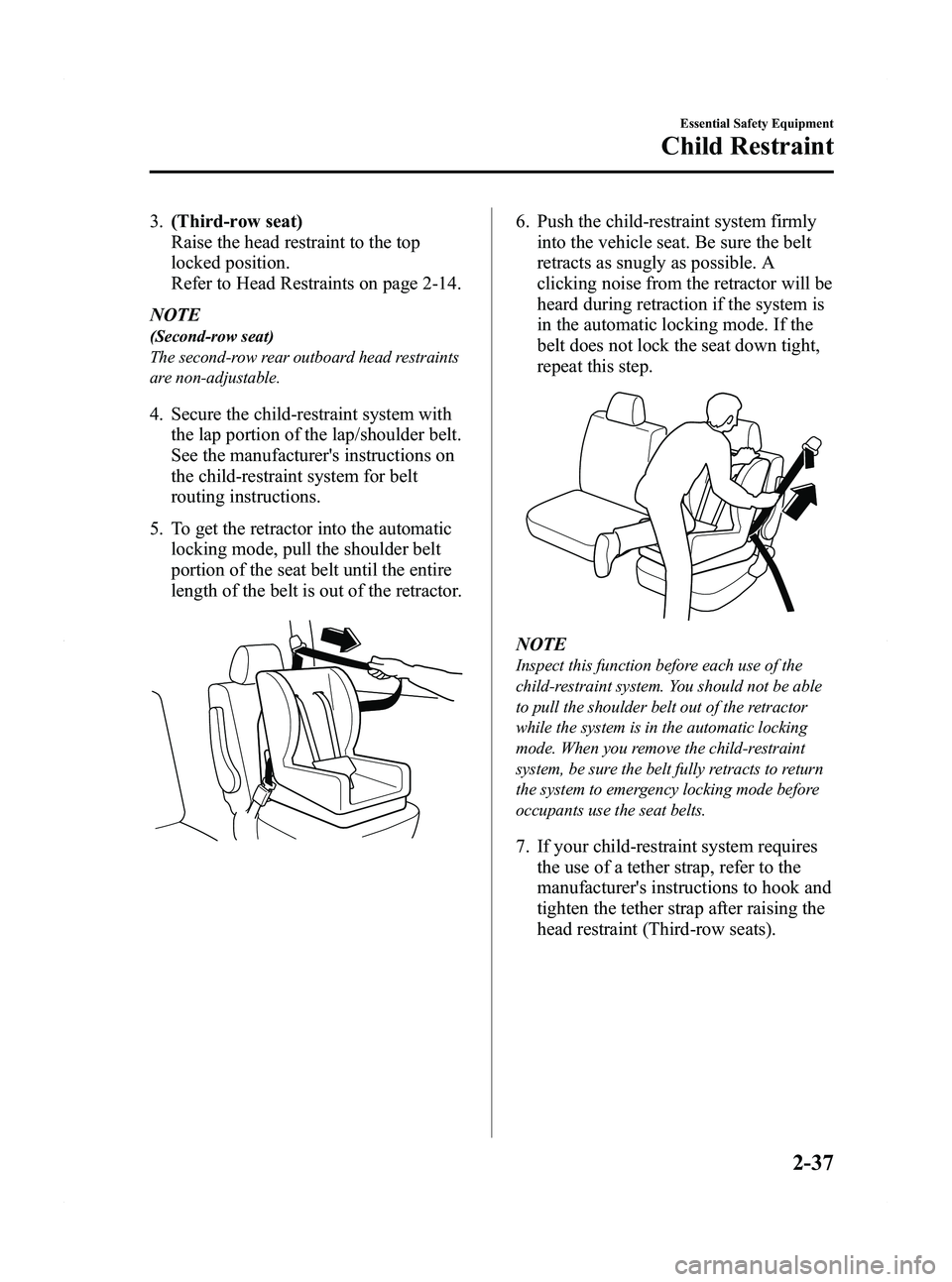
Black plate (49,1)
3.(Third-row seat)
Raise the head restraint to the top
locked position.
Refer to Head Restraints on page 2-14.
NOTE
(Second-row seat)
The second-row rear outboard head restraints
are non-adjustable.
4. Secure the child-restraint system with the lap portion of the lap/shoulder belt.
See the manufacturer's instructions on
the child-restraint system for belt
routing instructions.
5. To get the retractor into the automatic locking mode, pull the shoulder belt
portion of the seat belt until the entire
length of the belt is out of the retractor.
6. Push the child-restraint system firmlyinto the vehicle seat. Be sure the belt
retracts as snugly as possible. A
clicking noise from the retractor will be
heard during retraction if the system is
in the automatic locking mode. If the
belt does not lock the seat down tight,
repeat this step.
NOTE
Inspect this function before each use of the
child-restraint system. You should not be able
to pull the shoulder belt out of the retractor
while the system is in the automatic locking
mode. When you remove the child-restraint
system, be sure the belt fully retracts to return
the system to emergency locking mode before
occupants use the seat belts.
7. If your child-restraint system requiresthe use of a tether strap, refer to the
manufacturer's instructions to hook and
tighten the tether strap after raising the
head restraint (Third-row seats).
Essential Safety Equipment
Child Restraint
2-37
Mazda5_8BR9-EA-10J_Edition3 Page49
Monday, February 21 2011 1:44 PM
Form No.8BR9-EA-10J
Page 52 of 440

Black plate (52,1)
Do not allow a child to lean over or
against the side window of a vehicle
with side air bags:Allowing anyone to lean over or
against the front door is dangerous.
If the vehicle is equipped with side air
bags, the impact of an inflating side
air bag could cause serious injury or
death to the person. Children are
more likely to sleep in the vehicle;
when they do, they are more at risk
in the front passenger's seat that has
a side air bag because they may
slump over into the path of the
seatback-mounted air bag.
Furthermore, leaning over or against
the doors could block the side air bag
and eliminate the advantages of
supplemental protection. With the
front air bag and the additional side
air bag that deploys from the
outboard shoulder of the front
passenger seat, the rear seat is
always a better location for children
who are prone to sleeping. If a child
cannot be seated in the rear, do not
allow the child to lean over or
against the side window, even if the
child is seated in a child-restraint
system. Do not allow a child or anyone to lean
over or against the side window of a
vehicle with side and curtain air bags:
It is dangerous to allow anyone to
lean over or against the side window,
the area of the front passenger seat,
the front and rear window pillars and
the roof edge along both sides from
which the side and curtain air bags
deploy, even if a child-restraint
system is used. The impact of
inflation from a side or curtain air
bag could cause serious injury or
death to an out of position child.
Furthermore, leaning over or against
the front door could block the side
and curtain air bags and eliminate
the advantages of supplemental
protection. With the front air bag and
the additional side air bag that
comes out of the front seat, the rear
seat is always a better location for
children. Take special care not to
allow a child to lean over or against
the side window, even if the child is
seated in a child-restraint system.
qFront Passenger's Seat Child-
Restraint System Installation
1. Switch the ignition ON.
2. Slide the seat as far back as possible.
2-40
Essential Safety Equipment
Child Restraint
Mazda5_8BR9-EA-10J_Edition3 Page52
Monday, February 21 2011 1:44 PM
Form No.8BR9-EA-10J